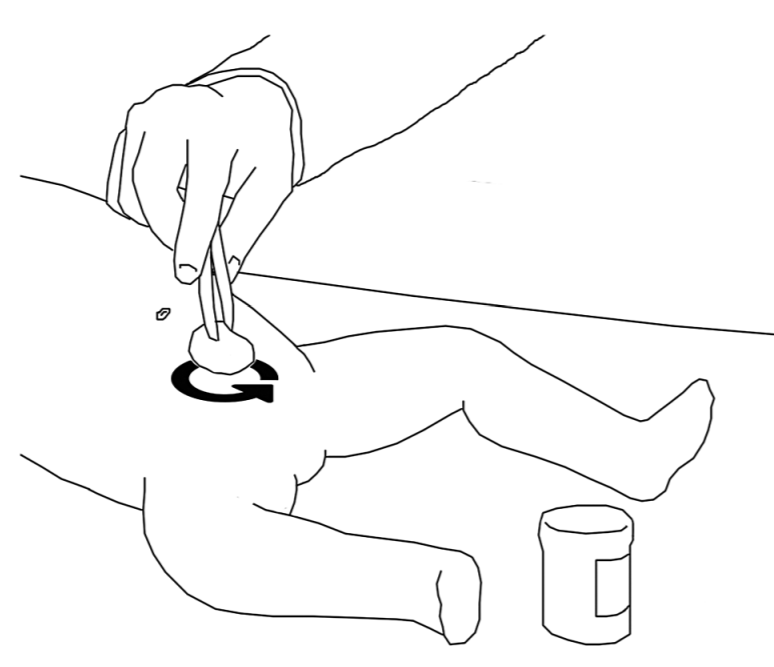Cellulitis presents with an acute onset of red, painful, hot, swollen, and tender skin, with possible blister or bullae formation. The leg is the most commonly affected site, presentation is usually unilateral. Often (but not always) associated with a break in the skin (portal entry).
If patient afebrile and tolerating oral antibiotics, can be managed in primary care. Caution with immunocompromised patients.
Most children with infected eczema do not benefit from antibiotic therapy (oral or topical) - except those with a severe infection. Optimisation of topical steroids is the mainstay of treatment in these patients.
For limited non-bullous impetigo, use a topical antiseptic, such as hydrogen peroxide 1% cream applied 2 to 3 times a day for 5-7 days
or
topical Abs (fusidic acid 2% cream or mupirocin 2% ointment) tds for 5-7 days.
Cefalexin for 5-7 days. 12.5mg/kg bd (max 1g per dose) or 1-11 months: 125mg bd. 1 year - 4 years: 125mg tds. 5-11 years: 250mg tds. 12 years and over: 500mg bd-tds.
or
Flucloxacillin for 5-7 days. 1 month to less than 2 year: 62.5-126mg qds. 2 years to less than 10 years: 125-250mg qds. 10-17 years: 250-500mg qds
If facial cellulitis, Co-amoxiclav for 5-7 days. 1-11 months: 0.25 mL/kg of 125/31 co-amoxiclav liquid tds. 1-5 years: co-amoxiclav 125/31 liquid 5mL tds. 6-11 years co-amoxiclav 250/62 liquid 5mL tds. 12-17 years co-amoxiclav tablets (500/125mg) 1tds or co-amoxiclav 250/62 liquid 10mL tds.
If allergic to penicillin: Clarithromycin for 5-7 days. Dose: Under 8kg: 7.5 mg/kg bd. 8 to 11kg: 62.5 mg bd. 12 to 19kg: 125 mg bd. 20 to 29kg: 187.5 mg bd. 30 to 40kg: 250mg bd. 12 to 17 years: 250mg bd
Most children with infected eczema do not benefit from antibiotic therapy (oral or topical) - except those with a severe infection. Optimisation of topical steroids is the mainstay of treatment in these patients.
Provide safety netting information (verbal and written).
Note: aim to use an antibiotic that minimises dosing frequency and is palatable (if suspension prescribed) to optimise adherence. QDS penicillin V and flucloxacillin suspensions are not well tolerated by children.
It can sometimes be challenging for children to swallow large volumes of suspensions. Most school age children (from above 4 years of age) can be taught to swallow tablets. The following website provides great information for parents on teaching their child to swallow tables - www.pillswallowing.com
References
- BNF-C accessed at https://bnfc.nice.org.uk in August 2019.
- NICE (2019). Cellulitis and erysipelas: antimicrobial prescribing.
- Dillon HC Jr. Treatment of staphylococcal skin infections: a comparison of cephalexin and dicloxacillin. J Am Acad Dermatol. 1983 Feb;8(2):177-81.
- Aboltins CA et al. Oral versus parenteral antimicrobials for the treatment of cellulitis: a randomized non-inferiority trial. J Antimicrob Chemother. 2015 Feb;70(2):581-6.
- Baguley D, Lim E, Bevan A, Pallet A and Faust SN. Prescribing for children – taste and palatability affect adherence to antibiotics: a review Archives of Disease in Childhood 2012;97:293-297
- Falagas ME, Karagiannis AKA, Nakouti T, Tansarli GS. Compliance with Once-Daily versus Twice or Thrice-Daily Administration of Antibiotic Regimens: A Meta-Analysis of Randomized Controlled Trials. PLoS ONE. 2015;10(1):e0116207. doi:10.1371/journal.pone.0116207.
- Bielicki JA, Barker CI, Saxena S, Wong IC, Long PF, Sharland M. Not too little, not too much: problems of selecting oral antibiotic dose for children. BMJ. 2015 Nov 3;351:h5447.
- Malhotra-Kumar S, Lammens C, Coenen S, Van Herck K, Goossens H. Effect of azithromycin and clarithromycin therapy on pharyngeal carriage of macrolide-resistant streptococci in healthy volunteers: a randomised, double-blind, placebo-controlled study. Lancet. 2007 Feb 10;369(9560):482-90.
- Dancer SJ. Attention prescribers: be careful with antibiotics. Lancet. 2007 Feb 10;369(9560):442-3.
- Koning S et al. Interventions for impetigo. Cochrane database of systematic reviews 2012.
Click here for tips for antibiotic prescribing in children and the evidence base supporting them





